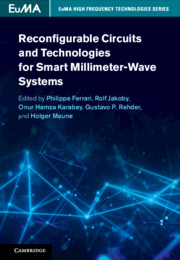Book contents
- Reconfigurable Circuits and Technologies for Smart Millimeter-Wave Systems
- EuMA High Frequency Technologies Series
- Reconfigurable Circuits and Technologies for Smart Millimeter-Wave Systems
- Copyright page
- Contents
- Contributors
- Preface
- Abbreviations
- 1 Introduction and Motivation
- 2 Reconfigurable Devices and Smart Antennas
- 3 CMOS and BiCMOS Technologies
- 4 RF MEMS Technology
- 5 Microwave Liquid Crystal Technology
- Book part
- Index
- References
2 - Reconfigurable Devices and Smart Antennas
Published online by Cambridge University Press: 20 May 2022
- Reconfigurable Circuits and Technologies for Smart Millimeter-Wave Systems
- EuMA High Frequency Technologies Series
- Reconfigurable Circuits and Technologies for Smart Millimeter-Wave Systems
- Copyright page
- Contents
- Contributors
- Preface
- Abbreviations
- 1 Introduction and Motivation
- 2 Reconfigurable Devices and Smart Antennas
- 3 CMOS and BiCMOS Technologies
- 4 RF MEMS Technology
- 5 Microwave Liquid Crystal Technology
- Book part
- Index
- References
Summary
This chapter provides basic knowledge on technologies and circuits for future communication systems. Based on upcoming mm-wave communications, system requirements are derived. E.g. link analysis is used to visualize the need for high-gain antenna systems, which are further investigated in different scenarios such as stationary and mobile use cases. The chapter further gives an overview on different tunable circuits and devices such as phase shifters for antennas systems or tunable filters. The chapter feastures an overview of different technologies available to implement the required fuinctionality. The individual technologies will be described in full detail in later chapters
Keywords
- Type
- Chapter
- Information
- Publisher: Cambridge University PressPrint publication year: 2022

